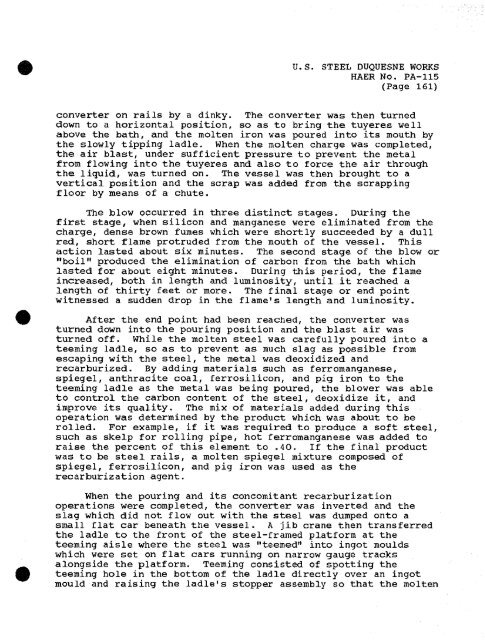pa1778data.pdf
pa1778data.pdf
pa1778data.pdf
You also want an ePaper? Increase the reach of your titles
YUMPU automatically turns print PDFs into web optimized ePapers that Google loves.
U.S. STEEL DUQUESNE WORKS<br />
HAER NO. PA-115<br />
(Page 161)<br />
converter on rails by a dinky. The converter was then turned<br />
down to a horizontal position, so as to bring the tuyeres well<br />
above the bath, and the molten iron was poured into its mouth by<br />
the slowly tipping ladle. When the molten charge was completed,<br />
the air blast, under sufficient pressure to prevent the metal<br />
from flowing into the tuyeres and also to force the air through<br />
the liquid, was turned on. The vessel was then brought to a<br />
vertical position and the scrap was added from the scrapping<br />
floor by means of a chute.<br />
The blow occurred in three distinct stages. During the<br />
first stage, when silicon and manganese were eliminated from the<br />
charge, dense brown fumes which were shortly succeeded by a dull<br />
red, short flame protruded from the mouth of the vessel. This<br />
action lasted about six minutes. The second stage of the blow or<br />
"boil" produced the elimination of carbon from the bath which<br />
lasted for about eight minutes. During this period, the flame<br />
increased, both in length and luminosity, until it reached a<br />
length of thirty feet or more. The final stage or end point<br />
witnessed a sudden drop in the flame's length and luminosity.<br />
After the end point had been reached, the converter was<br />
turned down into the pouring position and the blast air was<br />
turned off. While the molten steel was carefully poured into a<br />
teeming ladle, so as to prevent as much slag as possible from<br />
escaping with the steel, the metal was deoxidized and<br />
recarburized. By adding materials such as ferromanganese,<br />
Spiegel, anthracite coal, ferrosilicon, and pig iron to the<br />
teeming ladle as the metal was being poured, the blower was able<br />
to control the carbon content of the steel, deoxidize it, and<br />
improve its quality. The mix of materials added during this<br />
operation was determined by the product which was about to be<br />
rolled. For example, if it was required to produce a soft steel,<br />
such as skelp for rolling pipe, hot ferromanganese was added to<br />
raise the percent of this element to .40. If the final product<br />
was to be steel rails, a molten spiegel mixture composed of<br />
spiegel, ferrosilicon, and pig iron was used as the<br />
recarburization agent.<br />
When the pouring and its concomitant recarburization<br />
operations were completed, the converter was inverted and the<br />
slag which did not flow out with the steel was dumped onto a<br />
small flat car beneath the vessel. A jib crane then transferred<br />
the ladle to the front of the steel-framed platform at the<br />
teeming aisle where the steel was "teemed" into ingot moulds<br />
which were set on flat cars running on narrow gauge tracks<br />
alongside the platform. Teeming consisted of spotting the<br />
teeming hole in the bottom of the ladle directly over an ingot<br />
mould and raising the ladle's stopper assembly so that the molten

















